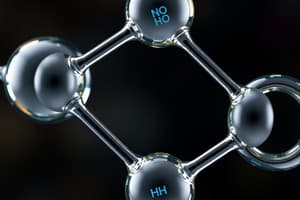Podcast
Questions and Answers
What type of bond is formed between oxygen and hydrogen atoms in a water molecule?
What type of bond is formed between oxygen and hydrogen atoms in a water molecule?
- Hydrogen bond
- Ionic bond
- Covalent bond (correct)
- Electrostatic bond
Why is the bond between oxygen and hydrogen atoms in a water molecule polar covalent?
Why is the bond between oxygen and hydrogen atoms in a water molecule polar covalent?
- Because hydrogen is a more electropositive atom
- Because oxygen is a more electronegative atom (correct)
- Because hydrogen is a more electronegative atom
- Because oxygen is a more electropositive atom
What is responsible for the high boiling point and surface tension of water?
What is responsible for the high boiling point and surface tension of water?
- Ionic bonds
- Electrostatic bonds
- Covalent bonds
- Hydrogen bonds (correct)
What type of charge is present on the oxygen atom in a water molecule?
What type of charge is present on the oxygen atom in a water molecule?
What is formed between water molecules due to the partial positive and negative charges?
What is formed between water molecules due to the partial positive and negative charges?
What is the term for the unequal sharing of electrons in a covalent bond?
What is the term for the unequal sharing of electrons in a covalent bond?
Flashcards are hidden until you start studying
Study Notes
Chemical Bonding in Water (H2O)
Covalent Bonds
- Water (H2O) is composed of two hydrogen atoms and one oxygen atom.
- The bond between oxygen and hydrogen atoms is a covalent bond, where electrons are shared between atoms.
- Each hydrogen atom shares two electrons with the oxygen atom to form a single covalent bond.
Polar Covalent Bonds
- The bond between oxygen and hydrogen atoms is polar covalent, meaning the electrons are not shared equally.
- Oxygen, being a more electronegative atom, pulls the shared electrons closer to itself, resulting in a partial positive charge on the hydrogen atoms.
- This creates a slight positive charge on the hydrogen atoms and a slight negative charge on the oxygen atom.
Molecular Polarity
- The unequal sharing of electrons and the resulting partial charges create a molecular dipole, making the water molecule (H2O) polar.
- The polarity of water is responsible for its unique physical and chemical properties, such as high surface tension and ability to dissolve a wide range of substances.
Hydrogen Bonds
- The partial positive charge on hydrogen atoms and the partial negative charge on the oxygen atom allow water molecules to form hydrogen bonds with each other.
- Hydrogen bonds are weak electrostatic attractions between molecules, which play a crucial role in the structure and properties of water.
- Hydrogen bonds are responsible for the high boiling point and surface tension of water, as well as its ability to dissolve ionic compounds.
Chemical Bonding in Water (H2O)
Covalent Bonds
- Water molecule is composed of two hydrogen atoms and one oxygen atom.
- Covalent bonds are formed between oxygen and hydrogen atoms by sharing electrons.
- Each hydrogen atom shares two electrons with the oxygen atom to form a single covalent bond.
Polar Covalent Bonds
- The covalent bond between oxygen and hydrogen is polar, meaning electrons are not shared equally.
- Oxygen's higher electronegativity pulls shared electrons closer, resulting in a partial positive charge on hydrogen atoms and a partial negative charge on the oxygen atom.
Molecular Polarity
- The unequal sharing of electrons creates a molecular dipole, making the water molecule (H2O) polar.
- The polarity of water is responsible for its unique physical and chemical properties, such as high surface tension and ability to dissolve a wide range of substances.
Hydrogen Bonds
- Partial positive charge on hydrogen atoms and partial negative charge on oxygen atoms allow water molecules to form hydrogen bonds.
- Hydrogen bonds are weak electrostatic attractions between molecules.
- Hydrogen bonds contribute to water's high boiling point and surface tension, as well as its ability to dissolve ionic compounds.
Studying That Suits You
Use AI to generate personalized quizzes and flashcards to suit your learning preferences.




